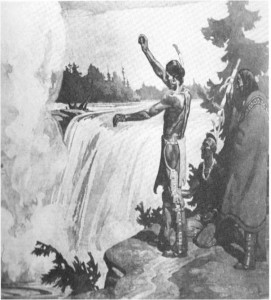

At the end of this period, in 1613, Nibachis, an Algonquin chief, showed Samuel de Champlain corn fields near his village just west of Ottawa. It is not known if tobacco was also grown locally then, but smoking pipes from this era have been found near Ottawa. In fact the same June, upon his return, Champlain witnessed the Pétun Sacrifice, the ceremonial offering of tobacco to the spirit of the Chaudière Falls, he wrote:
… We arrived at the Chaudière Falls, where the (Indians) had the accustomed ceremony…, where one of them, with a wooden plate takes up a collection, and each one of them puts into this plate a piece of tobacco… the plate is put into the middle of the band, and all dance round it, singing in their fashion… then one of the chiefs makes a speech, showing that for a long time they have been accustomed to make an offering, and that by this means they are guaranteed against their enemies; that otherwise misfortune would befall them, as the devil has persuaded them… the speaker takes the plate and … throws the tobacco into the middle of the caldron, and they raise a great cry all together…

Petun Ceremony
For the native peoples, the majesty of the Chaudière has been, and is, a sacred place, a natural shrine. Their long and complex relationship with the earth, water and sky of this cultural landscape expresses and harmonizes the Aboriginal unity with the natural and spiritual environment.
 Wordpress
Wordpress





